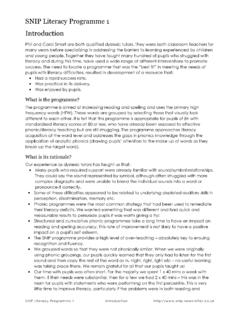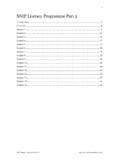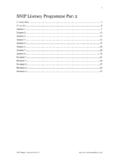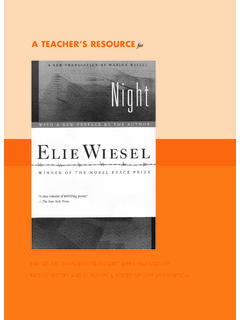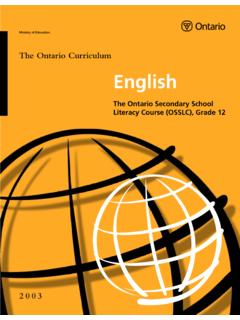Transcription of Get help and support KEY STG SCIENCE - AQA
1 KEY STAGE 3 SCIENCES yllabusAn approach to teaching the programme of studyVersion June 2016 Copyright 2016 AQA and its licensors. All rights retains the copyright on all its publications, including the syllabuses. However, schools and colleges registered with AQA are permitted to copy material from this syllabus for their own internal Education (AQA) is a registered charity (number 1073334) and a company limited by guarantee registered in England and Wales (company number 3644723). Our registered address is AQA, Devas Street, Manchester M15 help and supportVisit our website for information, guidance, support and resources at can talk directly to the SCIENCE subject teamE: 01483 477 756 3 Key Stage 3 SCIENCE .
2 Version for the most up-to-date syllabus, resources, support and administrationContents1 introduction 62 Enquiry processes Analyse patterns Discuss limitations Draw conclusions Present data Communicate ideas Construct explanations Critique claims Justify opinions Collect data Devise questions Plan variables Test hypotheses Estimate risks Examine consequences Review theories Interrogate sources 263 Subject content Forces Speed Gravity Contact forces Pressure Electromagnets Voltage and resistance Current Electromagnets
3 Magnetism Energy Energy costs Energy transfer Work Heating and cooling Waves Sound Light Wave effects Wave properties 424 Visit for the most up-to-date syllabus, resources, support and administrationAre you using the latest version of this syllabus? You will always find the most up-to-date version of this syllabus on our website at We will write to you if there are significant changes to this syllabus. Individial Subject content pages can be downloaded from our KS3 SCIENCE Syllabus is supported and co-developed by the Sheffield Institute of Education at Sheffield Hallam Matter Particle model Separating mixtures Periodic table Elements Reactions Metals and non-metals Acids and alkalis Chemical energy Types of reaction Earth Earth structure Universe Climate Earth resources Organisms Movement Cells Breathing Digestion Ecosystems Interdependence
4 Plant reproduction Respiration Photosynthesis Genes Variation Human reproduction Evolution Inheritance 674 Working scientifically activity grid 685 Practical skills 785 Key Stage 3 SCIENCE . Version for the most up-to-date syllabus, resources, support and administrationOverview of the KS3 SCIENCE SyllabusPart 1 Taught in year 7 or year 7/8*Part 2 Taught in year 8 or year 8/9*ForcesSpeedGravityContact forcesPressureElectromagnetsVoltage and resistanceCurrentElectromagnetsMagnetism EnergyEnergy costsEnergy transferWorkHeating and coolingWavesSoundLightWave effectsWave propertiesMatterParticle modelSeparating mixturesPeriodic tableElementsReactionsMetals and non-metalsAcids and alkalisChemical energyTypes of reactionEarthEarth structureUniverseClimateEarth resourcesOrganismsMovementCellsBreathing DigestionEcosystemInterdependencePlant
5 ReproductionRespirationPhotosynthesisGen esVariationHuman reproductionEvolutionInheritance* Suggested teaching: Each part should be taught over the period of minimum one processes: working scientificallyEnquire Collect data Devise questions Plan variables Test hypothesesSolve Estimate risks Examine consequences Review theories Interrogate sourcesAnalyse Analyse patterns Discuss limitations Draw conclusions Present dataCommunicate Communicate ideas Construct explanations Critique claims Justify opinions6 Visit for the most up-to-date syllabus, resources, support and administration1 IntroductionAim of our syllabusOur Key Stage 3 (KS3)
6 SCIENCE Syllabus will help you create engaging lessons and promotes teaching for understanding rather than covering fragmented content. By following the framework within this syllabus, you will understand what your students need to know by the end of Key Stage 3 (KS3). Using a logical order of objectives, this syllabus uses big ideas and mastery goals to equip students for success at GCSE. It also provides a method to follow student progress as their understanding develops during between the KS3 SCIENCE Syllabus and GCSE sciencesOur GCSE specifications describe content and processes that students need to demonstrate competence in.
7 These areas are developed in KS3 so that students enter Key Stage 4 (KS4) with a level of most cases, students have been studying SCIENCE for eight or nine years by the time they start GCSE courses. To reach their potential, they need to study the examined content with a mastery of ideas and skills. This KS3 SCIENCE Syllabus will help you identify what mastery looks like. You can use it with the accompanying resources to help your students develop their knowledge, from understanding to application. The big ideas principleStudents may complete KS3 with knowledge of individual concepts but lack the understanding to apply their knowledge to unfamiliar contexts.
8 This syllabus provides students with this understanding. Using the big ideas principle, the generalisations, principles and models which connect concepts are at the heart of our syllabus. We believe this is how students learn to see the world analytically, to explain phenomena and make predictions all skills they need for their next stage of scientific syllabus complements the programme of study by exploring links between the ideas at KS3. Teachers have told us the 140 ideas within the programme of study can lead to students moving to a new theme almost every lesson, this can prevent them from gaining a full understanding of key programme of study lists 140 biology, chemistry and physics ideas and don t distinguish what s most/least important, nor the links between ideas.
9 This syllabus provides an alternative approach to KS3 content. Content is under 10 big idea headings: Forces, Electromagnetism, Energy, Waves, Matter, Reactions, Earth, Organisms, Ecosystems and Genes. Each idea contains four smaller topics: the building blocks for the big Stage 3 SCIENCE . Version for the most up-to-date syllabus, resources, support and administrationA spiral design for understandingIt s easier for students to develop an understanding of a big idea by multiple interactions with the concepts within the idea. By connecting smaller ideas to more abstract ideas, students will be better prepared to apply these concepts when approaching an unfamiliar big idea topic contains four smaller topics that build in complexity.
10 For example Waves , topics are ordered from simpler, more concrete topics Light and Sound , to more abstract ones Wave properties and Wave effects . These have been created to avoid repetition, draw on various scientific skills and use different 1 Part 2 WavesSoundLightWave effectsWave propertiesComplexity of topics increasesOur suggested approach to the content is to tackle the first two topics within each idea during the first part of their studies (this should be a minimum of one year) and the third and fourth topics in the second part of their studies (this should also take the minimum of one year).











